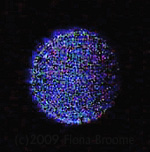As an Amazon Associate I earn from qualifying purchases. Click for details.
Orb sightings occur every day.
Most “ghost orbs” appear in photographs or videos in haunted places. So few people see them floating in mid-air, some researcher speculate that they can only be seen by gifted, psychic people.
What are orbs?
 “Orbs” usually refer to the round, usually translucent, round or ball-shaped images that we sometimes see in photographs.
“Orbs” usually refer to the round, usually translucent, round or ball-shaped images that we sometimes see in photographs.
They’re usually white, but sometimes appear in pastel colors. Rarely, they manifest as deep, rich and intense colors.
If you look at them closely, a few orbs seem to have faces in them. Some orbs seem to be made up of tiny facets. Most orbs appear as milky circles or spheres.
People often call them “ghost orbs,” since they seem to indicate paranormal energy.
However, many orbs in photos can be explained naturally. You can see the pollen in the middle, or the insect. The shape is usually irregular.
It may take you awhile to be able to tell the difference between an orb formed by moisture, a reflection, an insect, etc., but — once you can tell the difference — you’re not likely to confuse them again.
Don’t accept the easy dismissal of all orbs as dust, moisture, etc. See the photos in my 2013 article, What Is “Paranormal”?, if you think moisture or reflections always produce orbs.
I recommend trying to create fake orbs with your camera, before deciding what’s real and what isn’t. You may be surprised.
Unexplained orbs… they’re the orb sightings that really interest ghost hunters and paranormal researchers.
Orb sightings and the spirit world
Many people speculate about orb sightings. Some explanations include:
- Ghosts.
- Angels.
- Demons.
- An energy field indicating a portal opening or closing. (This is still my favorite explanation.)
- A friendly spirit, manifesting to say hello.
- A glimpse of “the light” that people describe in near-death experiences.
How to see orbs
The best way to see orbs is to take lots of photos in haunted locations, or places where people have seen (or photographed) orbs in the past.
These may include:
- Cemeteries
- Battlegrounds
- Theatres (or buildings that used to have stage performances)
- Older hotels
- Living history museums
- Historic homes (especially pre-1890 and open to the public)
Take dozens of photos, if you can. Study them closely for orbs. Adjust the contrast or lightness of the photo, so you don’t miss anything.
Tips for orb photography
 Day or night, use your camera’s flash. It is possible to photograph ghost orbs during the daytime (see the orb on my book cover for The Ghosts of Austin, Texas) , but a flash seems to improve results.
Day or night, use your camera’s flash. It is possible to photograph ghost orbs during the daytime (see the orb on my book cover for The Ghosts of Austin, Texas) , but a flash seems to improve results.- Always take two or three photos in a row, as quickly as possible and without changing position. See if the same orb or orbs are in all photos; if so, there may be a normal explanation.
- Save all of your photos until you exactly what to look for: Different colors, sizes, levels of contrast.
Tips for orb sightings
If you’re one of the fortunate few who see orbs floating in mid-air, here are tips to help you see more of them.
- Practice your orb-spotting skills. With a friend or two, visit known haunted locations.
- Most people spot orbs around dusk or immediately after it.
- When you see an orb, have friends take photos of the orb. If possible, also get photos of you with the orb to see if the locations are similar in most photos.
- Measure the temperature and EMF levels around the orb, if you have the tools to do so.
Orb sightings are a controversial topic in ghost hunting. However, if you’re fascinated by ghost orbs or find comfort in them, every orb sighting can be very important.
